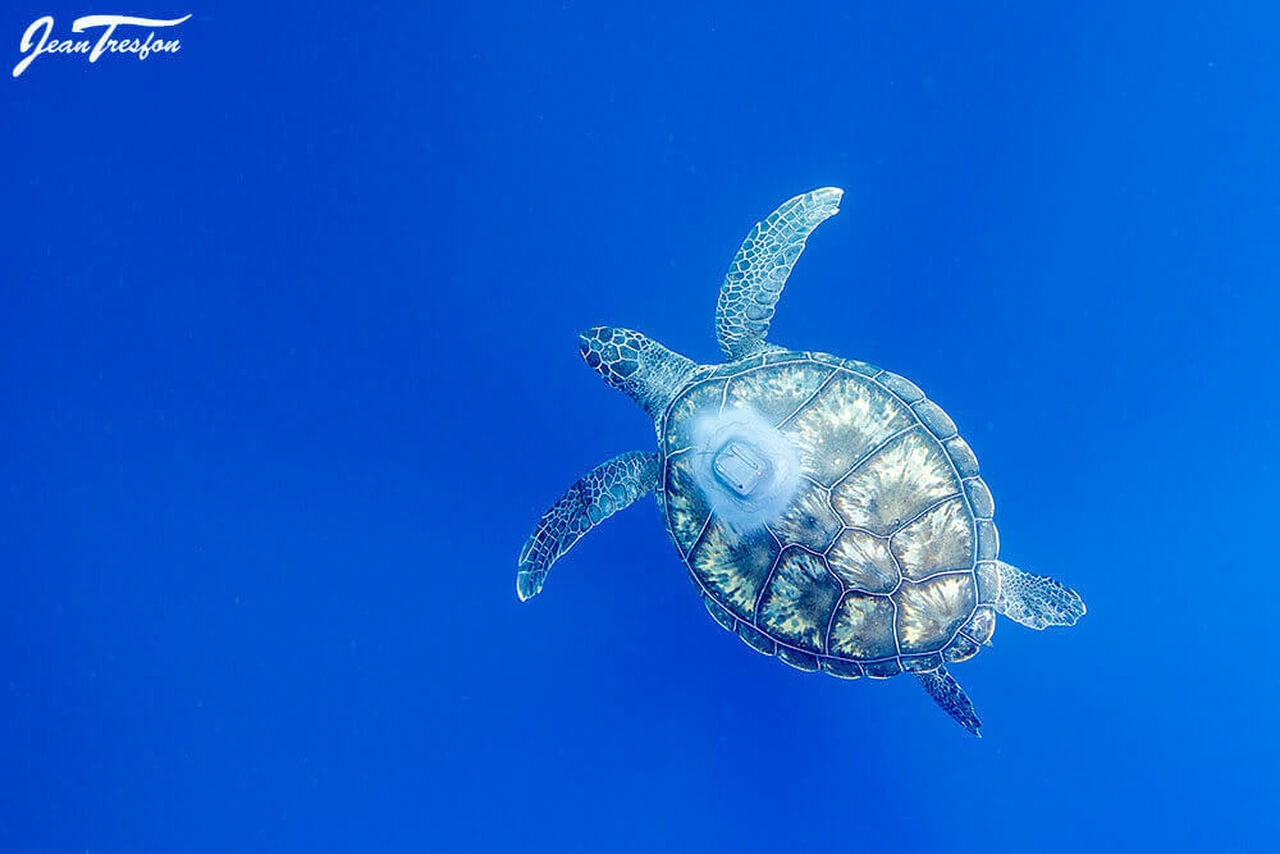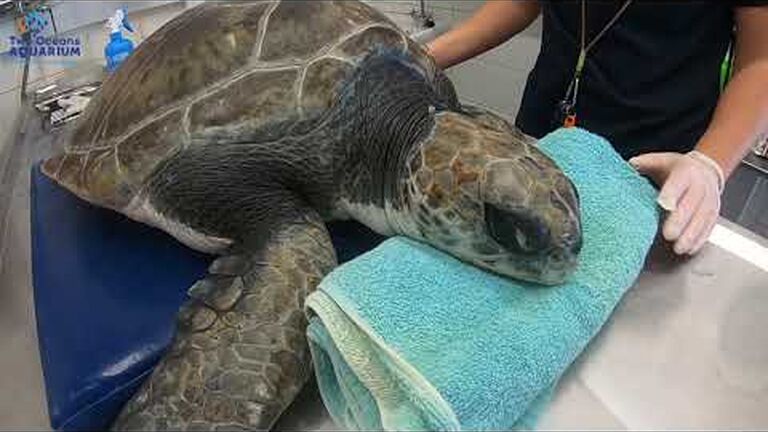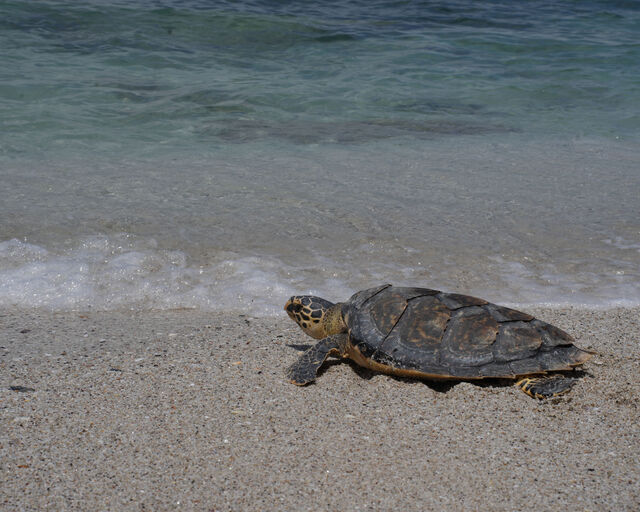The most fulfilling part of rescuing and rehabilitating sea turtles at the Two Oceans Aquarium is, of course, their release back into the ocean when they are fully recovered. The most exciting (and quite often, most stressful) part is tracking the oceanic movements of these sea turtles. Where will they go next? Are they ok?
Fortunately, thanks to modern satellite tracking technology and the collaboration of government, aquariums and generous donors, we are able to follow the journeys of some of our releases turtles closely - and provide you with their inspiring ocean adventure stories. Let's take a closer look at their travels.
Yoshi and Alvi aren't alone - other stranded turtles deserve a second chance too. Support the Turtle Rescue Programme of the Two Oceans Aquarium Foundation in its efforts to rescue, rehabilitate and release hundreds of stranded turtles each year:
25 June 2020
Alvi is on a mission, and is finally heading into the high seas after hugging the West Coast for a long time. Alvi was rescued after washing up on the beach at Struisbaai and recovered well after the rehabilitation team removed a plastic bag from his throat. Alvi was fitted with a satellite tag, supplied by the Department of Forestry, Fisheries and Environment, and released off Cape Point at the end of last year. He spent the first 4 months between Melkbos and Langebaan, a real Weskus local, and then travelled all along the continental shelf right into Namibian waters.
Alvi is currently heading towards the Walvis Ridge, which is a 3 000km long ocean ridge that stretches from the Namibian coast to the Mid-Atlantic Ridge near Tristan da Cunha. What is quite incredible is that he has now crossed the tracks of many of the other turtles we've released and tracked in the past: Winston the little hawksbill turtle released in 2015, Yoshi the absolute legend of a loggerhead turtle who was released in 2017, Pemba the olive ridley turtle who underwent rehabilitation at the Two Oceans Aquarium and uShaka Seaworld and was released in 2018, and Noci the loggerhead turtle who was released at the end of 2018. They all made good use of the Benguela coastal current as well as the Benguela ocean current.
25 April 2020
Yoshi has paid a visit to Eighty Mile Beach in Australia, and the search for her has been joined by indigenous Australian rangers of the Bidyandanga community.
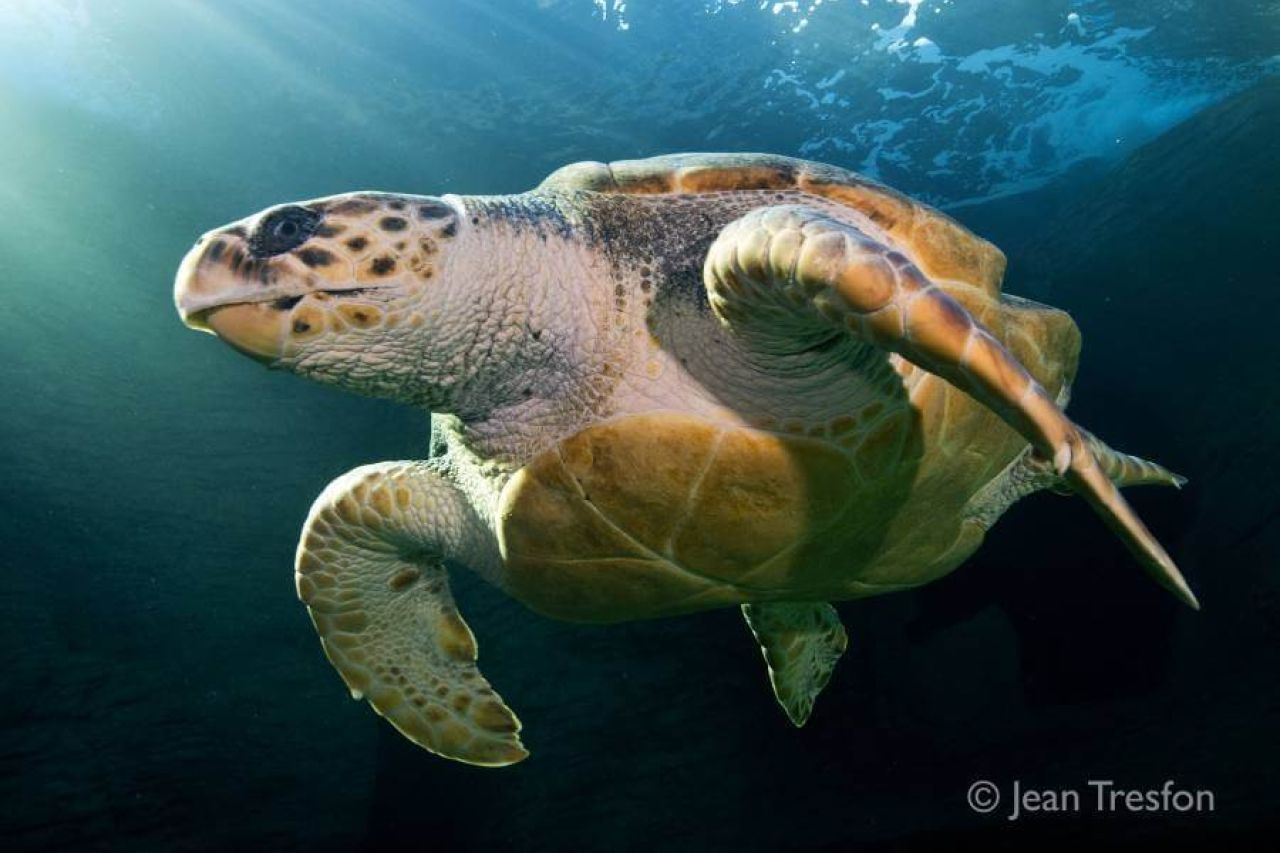
27 January 2020
Some real sea turtle excitement worldwide as Yoshi continued her incredible journey – 740 days and 35 400km (yes, an average of 48km per day – every day – for more than two years – definitely a record-setting migration).
The longest swim recorded by a human is 2 882km over 157 days by Ross Edgley (who lost chunks of his tongue during the swim due to extensive salt exposure). Humpback whale migrations have been recorded at about 5 000km – with a record of 8 000km. Yoshi would definitely be able to keep up with them. Yoshi has also covered more distance than our very famous great white shark, Nicole, who covered 11 000km to visit Australia in 2004. To try and put this into context – Yoshi has covered almost 1.5 million lengths of a Virgin Active Gym swimming pool.
She decided to not pop in at the Shark Bay World Heritage Area, as we predicted she would in December but is well on her way and about 500km north of Australia's Ningaloo Marine Park. Ningaloo Marine Park is just off the coast of the Cape Range National Park (declared in 1964) and is also an UNESCO World Heritage site due to the incredible underwater biodiversity. It is known as the best place in the world to see whale sharks, has more than 500 species of fish, more than 300 varieties of corals, with manta rays and sea turtles (maybe Yoshi soon) swimming around safely, and even humpback whales visiting in winter. Yoshi really picks her routes well – she has passed the most incredible marine protected areas.
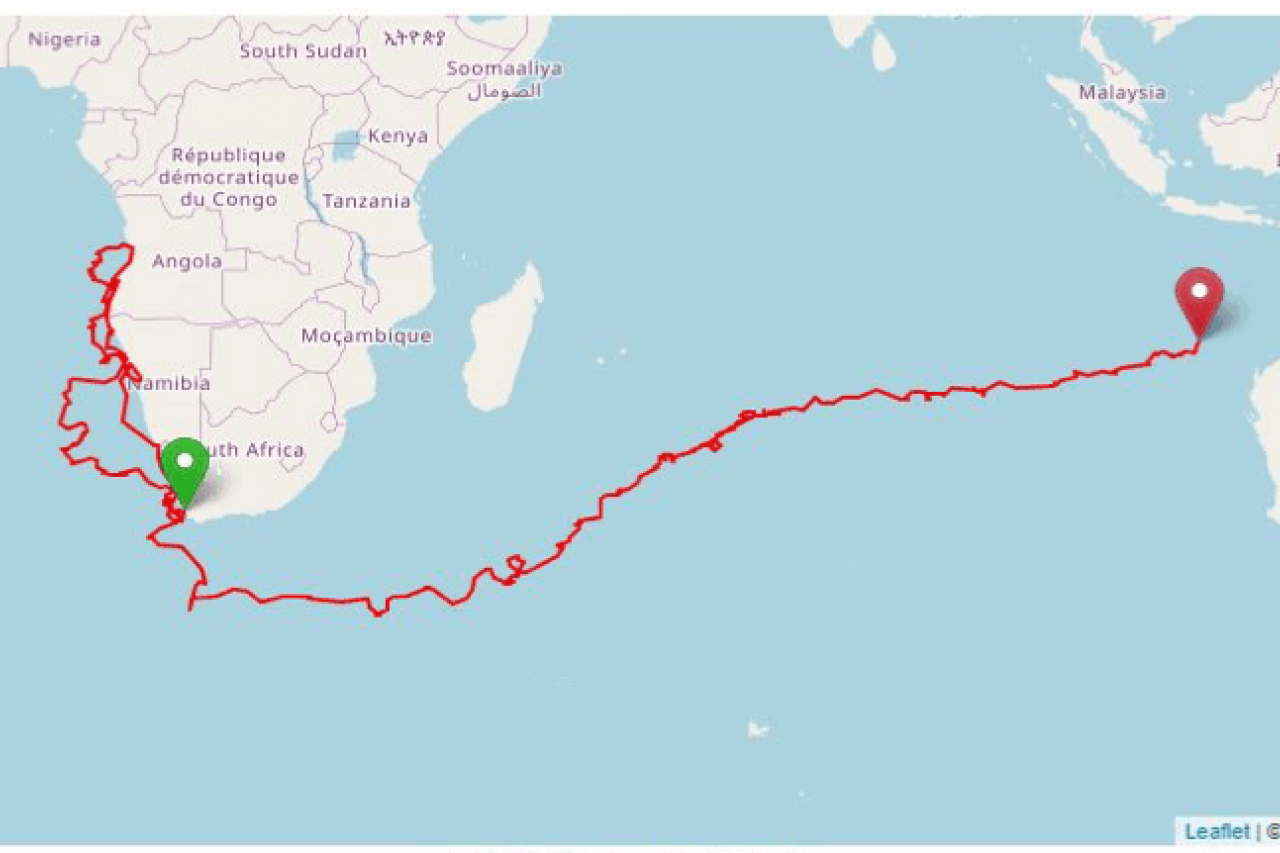
What is even more exciting is that Australian scientists from the Western Australian Department of Biodiversity, Conservation and Attractions as well as from Griffiths University, have made contact with us due to great interest in Yoshi’s journey but also in Yoshi (she might very well be an Aussie genetically). We are hoping, in collaboration with them and our own Oceans and Coast Department and local geneticists, that we might just be able to figure this out. They are also on standby should she decide to head to shore and nest. To have global support for Yoshi is just incredible!
Right now she is, as usual, moving between distinctive ridges (which means more food). She is about 150km north of the Sonja Ridge, 210km north of the Cape Range Fracture Zone and about 290km north of the Cuvier Basin. During the Late Jurassic this area formed part of Gondwanaland – which was pretty much composed of South American and African landmasses on the west and Antarctic, Madagascan, Great Indian and Australian landmasses in the east – before it separated off into the continents we know today.
She is in a lovely warm 27°C, with a very gentle SE current and a southerly wind of about 13km/h. Great conditions for this very fit turtle!
It is, of course, impossible to predict whether she will head towards the coastline or continue on her journey and possibly go to Queensland where there is a smaller nesting population of loggerheads. Or, in true Yoshi style, she might just end up being the first recorded loggerhead sea turtle to cross three oceans as she continues her world travels (Yoshi Magellan has a good ring to it).
What we do know is that Yoshi is most definitely the legend of legends when it comes to ocean travelling, and she has well surpassed Adelita’s 10 000 km Pacific ocean crossing (Adelita was the loggerhead turtle released off Mexico after 10 years under captive care - her release is what inspired us to release Yoshi).
Just keep swimming Yoshi, just keep swimming.
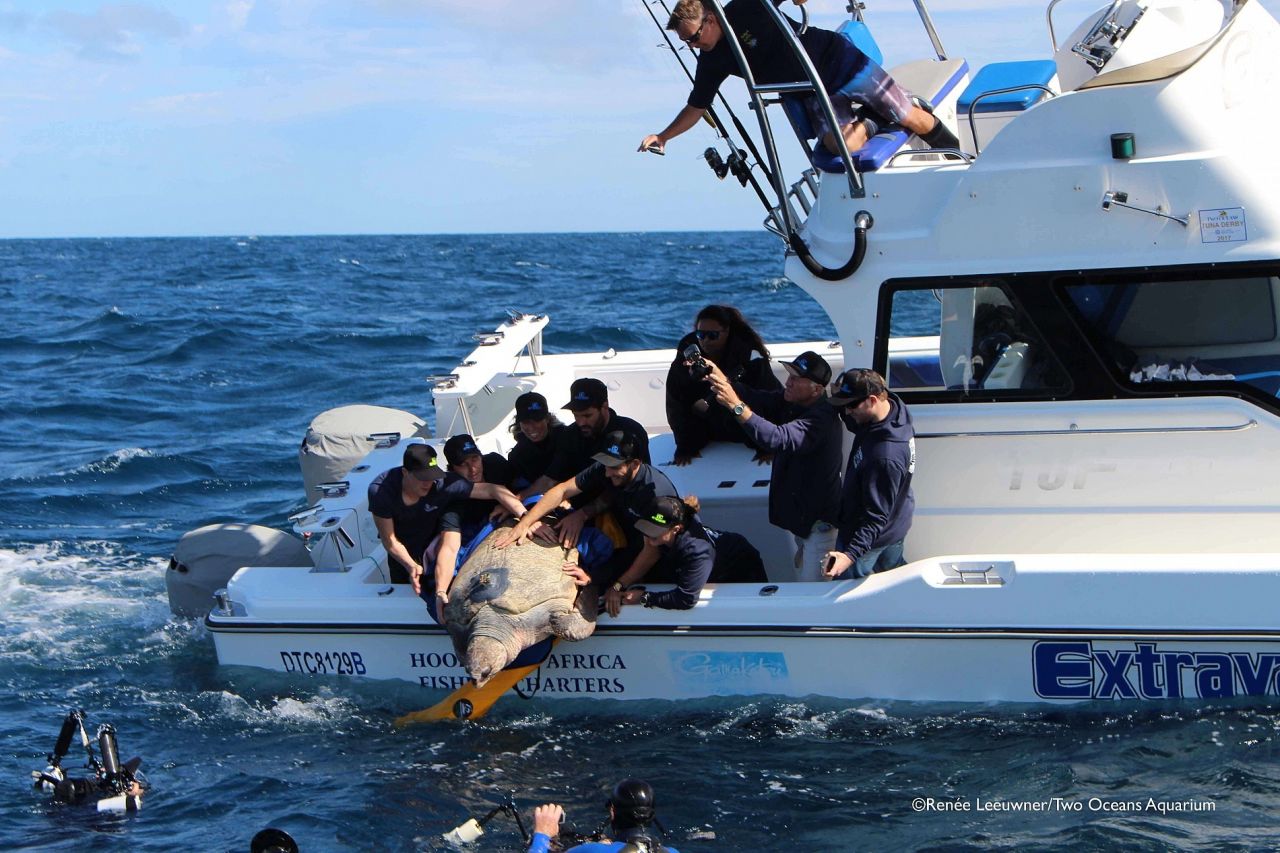
Alvi is doing well too - it seems as if all our rehabilitated green turtles truly believe that ‘Wes kus is die bes kus’ and Alvi has been rendezvousing between St Helena Bay and Elands Bay for most of the festive season, before heading back to Paternoster and also spending quite a bit of time off Cape Columbine.
He has since moved towards Saldanha Bay and is about 65km offshore west of Saldanha in a manageable 16°C. We're really excited to see where he will be heading next. It is a big ocean out there with a lot of warmer water to explore.
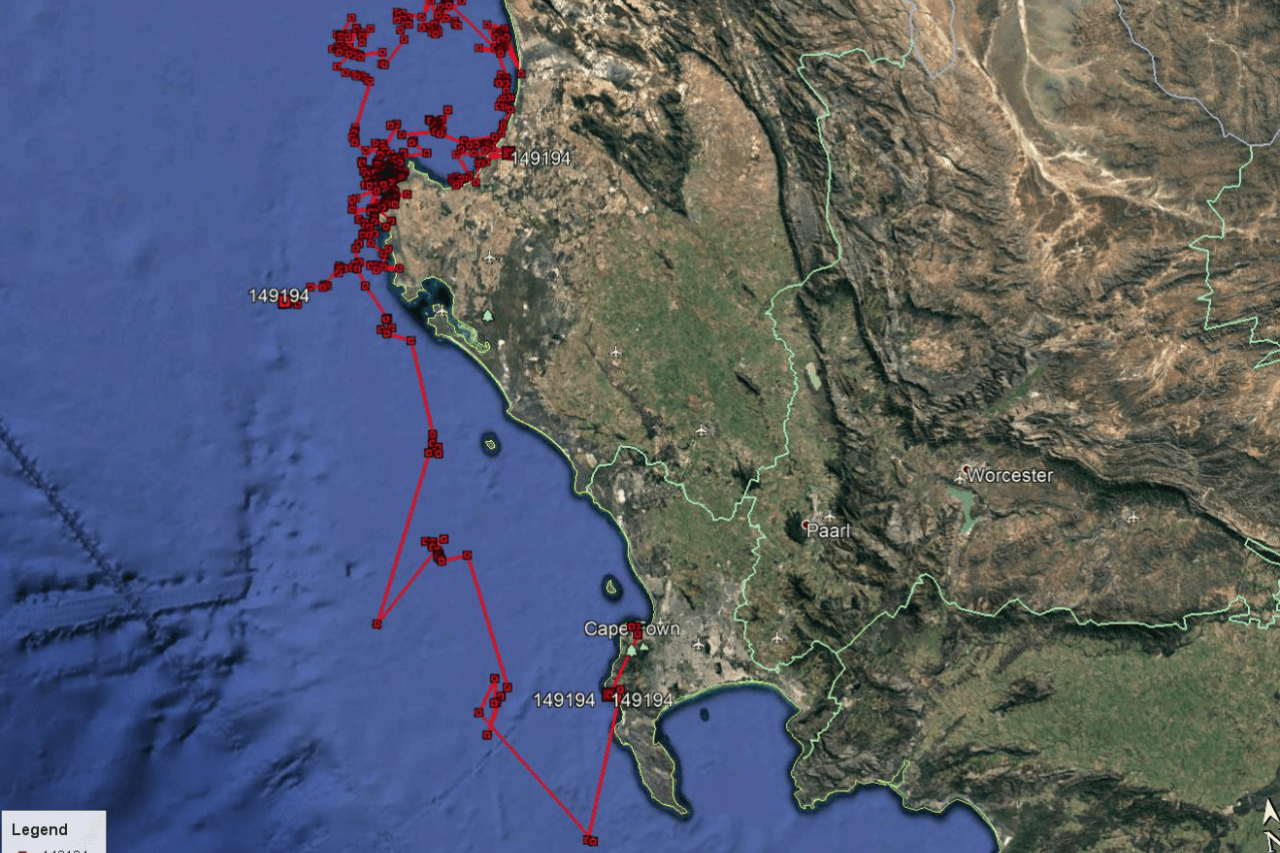
24 December 2019
Yoshi has now covered 34 000 kilometres since her release two years ago in December 2017! What an incredible achievement. That is 46.5km per day on average and an average speed of 1.94km/hour. She explored the Atlantic Ocean before venturing into the warm Indian Ocean, and is now about 1 278km north-west of Australia. It seems as if she is heading straight towards the Dirk Hartog Island, which is part of Shark Bay World Heritage Area. This is great news for Yoshi and for us – what a clever turtle.
The Dirk Hartog Island was discovered by Mr Hartog himself, while on a Dutch East India Company vessel, called the Eendracht, en route from Cape Town to Jakarta, in 1616. How apt that Yoshi has travelled this route as well (with an added loop up the West Coast to Angola of course). This island has an annual loggerhead nesting population of about 1400 females and is a protected area with a well-established monitoring program.
The Shark Bay area (about 200 000 hectares) was listed in 1991 as a UNESCO World Heritage area and Australia thus has an international obligation to protect, conserve and rehabilitate this area which has cultural, historical and scientific significance. The Shark bay area has vast sea-grass beds, the largest and richest in the world. It is also home to a large population of dugongs (sea cows – who love seagrass of course) and it is also known for its stromatolites – colonies of algae which formed hard, dome-shaped deposits and are among the oldest forms of life on earth. This area is also a refuge for various globally threatened marine species. I reckon if I had a choice of where to spend some time in a beautiful warm and protected area with plenty of food, I would choose the Shark Bay World Heritage Area too. Yoshi is in lovely 27°C water at the moment with a gentle current from a north-westerly direction pushing her along, but she is swimming against quite a tough easterly wind.
Yoshi’s satellite tag was one of our best investments ever. We have received 20 158 messages from 4 672 satellite passes. We are collaborating with Department of Environment, Fisheries and Forestry on the satellite transmissions of Yoshi, and her Wildlife Computers tag sends data directly to the ARGOS platform.
Yoshi is currently 8 000 km east of the Two Oceans Aquarium and 7 500 km north of the South Pole. She might also still fancy going to crabby Christmas Island (1 352km east of her) or to Bali (2 125km east of her current position).
What an incredible journey. And what an incredible turtle – her built-in GPS is certainly directing her to a safe marine area where she could very possibly originally be from. It would be amazing to see her nest along the West Australian coastline where the Gnaraloo Wilderness Foundation’s Gnaraloo Sea Turtle Conservation project protects and monitors this genetically distinct population in a marine protected area.
The value of Marine Protected Areas is enormous, and that is why we support the drive to declaring and protecting more marine areas along our own coastline. In 2019 we went from 0.4% to 5% of our oceans protected around South Africa when 20 new marine protected areas were declared.
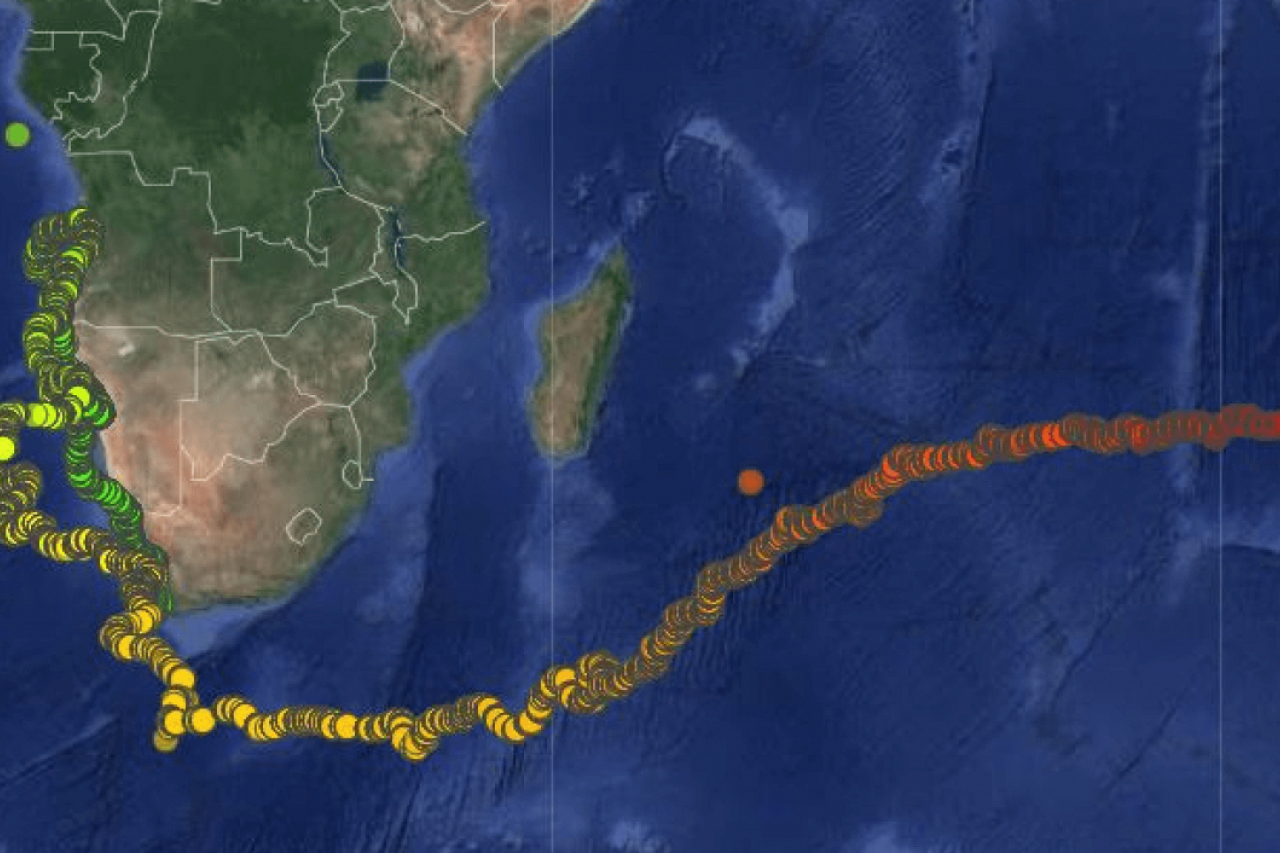
Alvi, the little green turtle who recovered so well after having ingested a nasty single-use plastic packet, is loving the West coast. Alvi has been back in the ocean for almost a month now and wasted no time before heading towards St Helena Bay. He seemed to have really enjoyed his time off Paternoster, which is one of the oldest fishing villages on our West Coast.
Cape Columbine, just around the corner, has South Africa's very last manned lighthouse and a large seal colony. Alvi passed Veldrif and Laaiplek (mouth of the Berg River) and is transmitting from Dwarskersbos at the moment. This is a little fishing village and also the area where Vasco da Gama first set foot on South African soil in 1497 after he rounded the Cape on the first recorded ocean route between Portugal and the East.
Sandy, our rescued sea turtle who survived a very nasty boat strike, also loved the West Coast, and spent about 6 months exploring this area. The water is a very nice and mild 18°C at the moment – so Alvi is certainly enjoying his time in this area.
11 November 2019
32 seems to be quite a significant number in South Africa at the moment, and Yoshi has decided to honour our Rugby World Cup victory by clocking up a solid 32 thousand kilometres!
Yoshi has been back in the ocean since 16 December 2017 and has covered an average of 46km’s per day for 694 days consecutively. That is absolutely incredible.
She has just crossed the Ninety East Ridge, which is the mid-ocean ridge on the Indian Ocean floor dividing the Indian Ocean into the West and East Indian Ocean. This ridge is a great location for Yoshi to feed – probably still her favourite pastime.
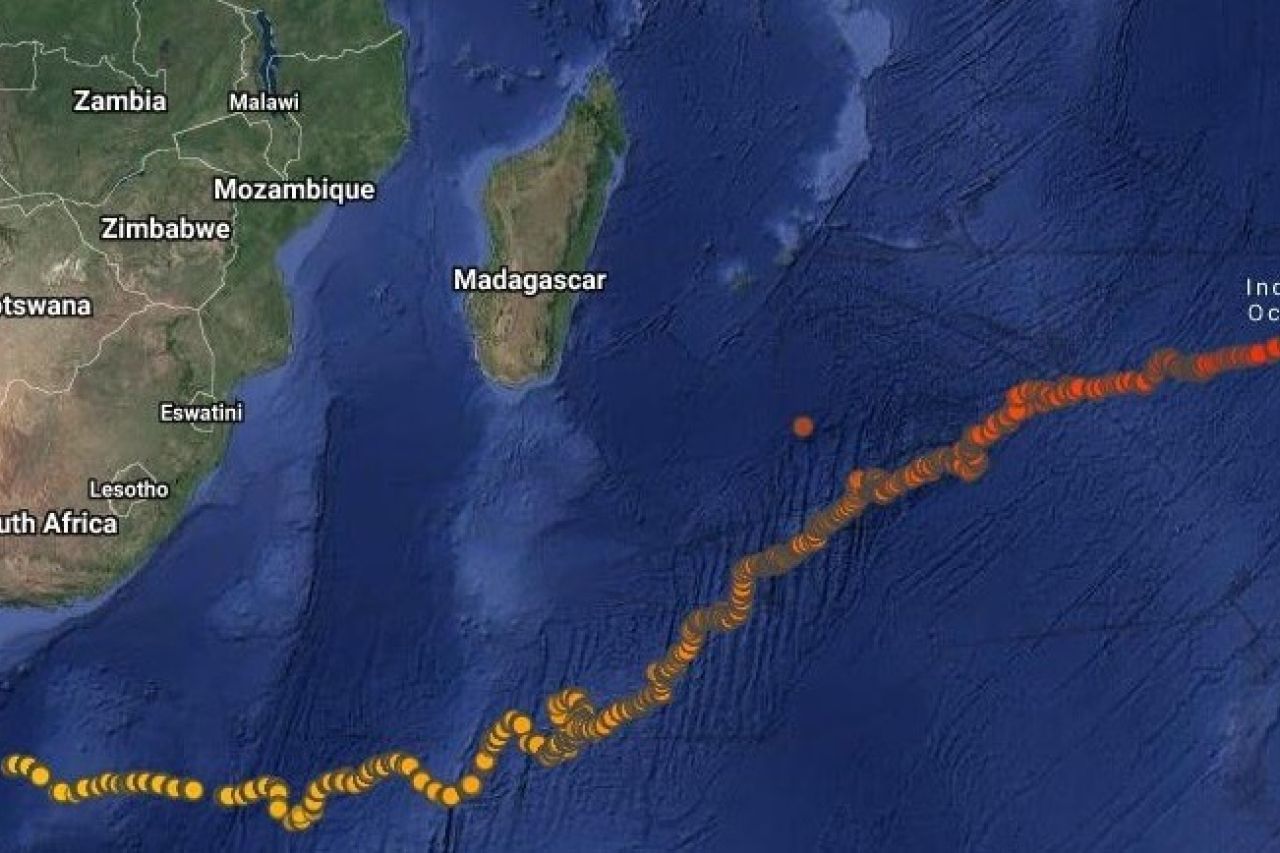
3 August 2019
Our travelling loggerhead turtles are doing really well, and the rescued loggerhead turtle, Anette, is also doing well in our turtle rehabilitation unit. Anette was entangled, together with a Cape fur seal, in a fishing net and washed up on the beach where both these animals were freed by the awesome team from the Kommetjie NSRI station.
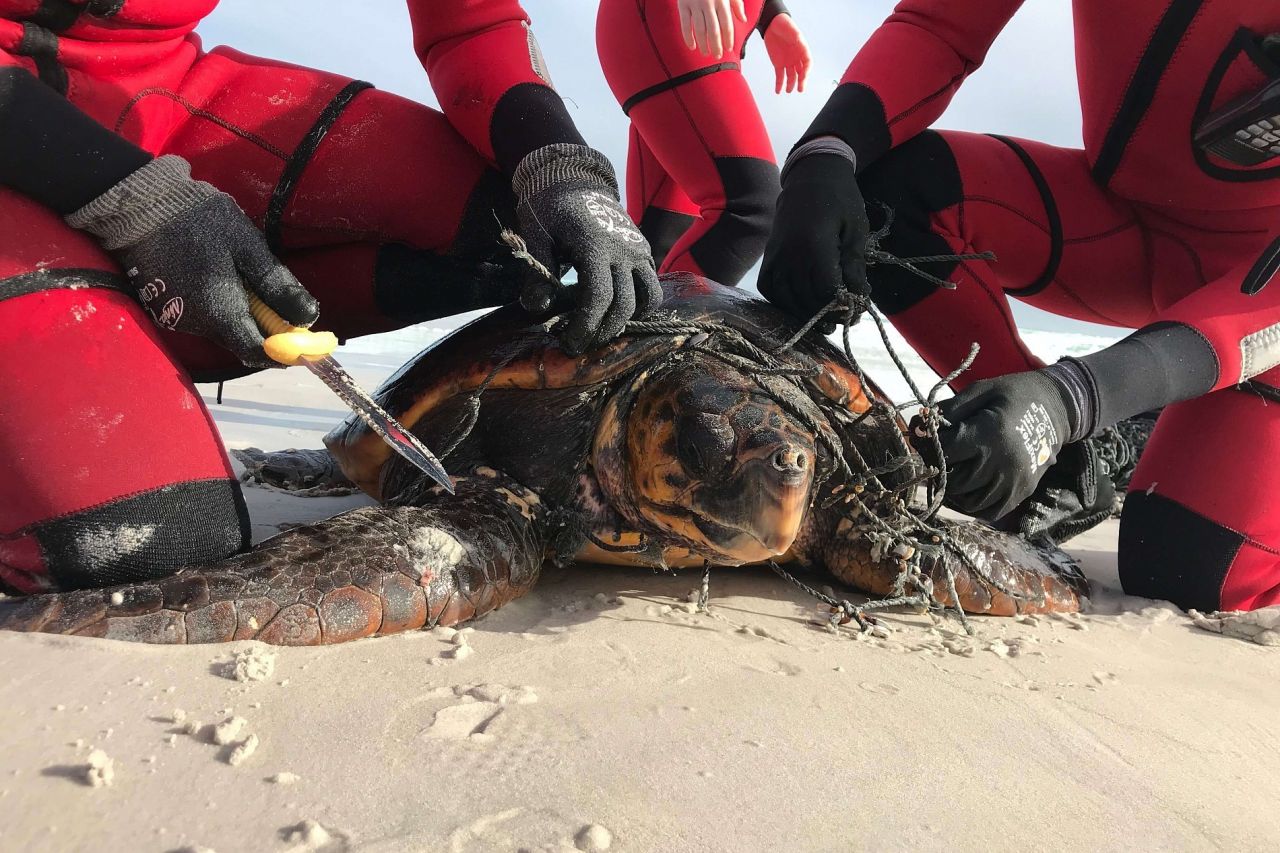
As soon as we have completed our full analysis on Sandy and Pemba's transmitter data we will share the more detailed travels of these amazing turtles.
20 May 2019
Pemba was released on the 8th of March 2018, and we were very lucky to have been able to track her for 424 days (14 months) before transmissions stopped on the 6th of May. This is very much in line with what we experienced when we tracked the two hawksbill turtles, Otto and Winston, both transmitting for 14 months. Pemba’s tag sent 21 727 messages over this time – quite a bit more than Yoshi’s thus far, and hence the battery running down quicker than Yoshi’s.
However, she managed to travel 16 664 kilometres since her release, which was a very impressive 39.3km per day! She did not slow down over the last 3 weeks of transmission, which is another sign that she was strong and healthy. In fact, on her last day of transmission, she moved 37km.
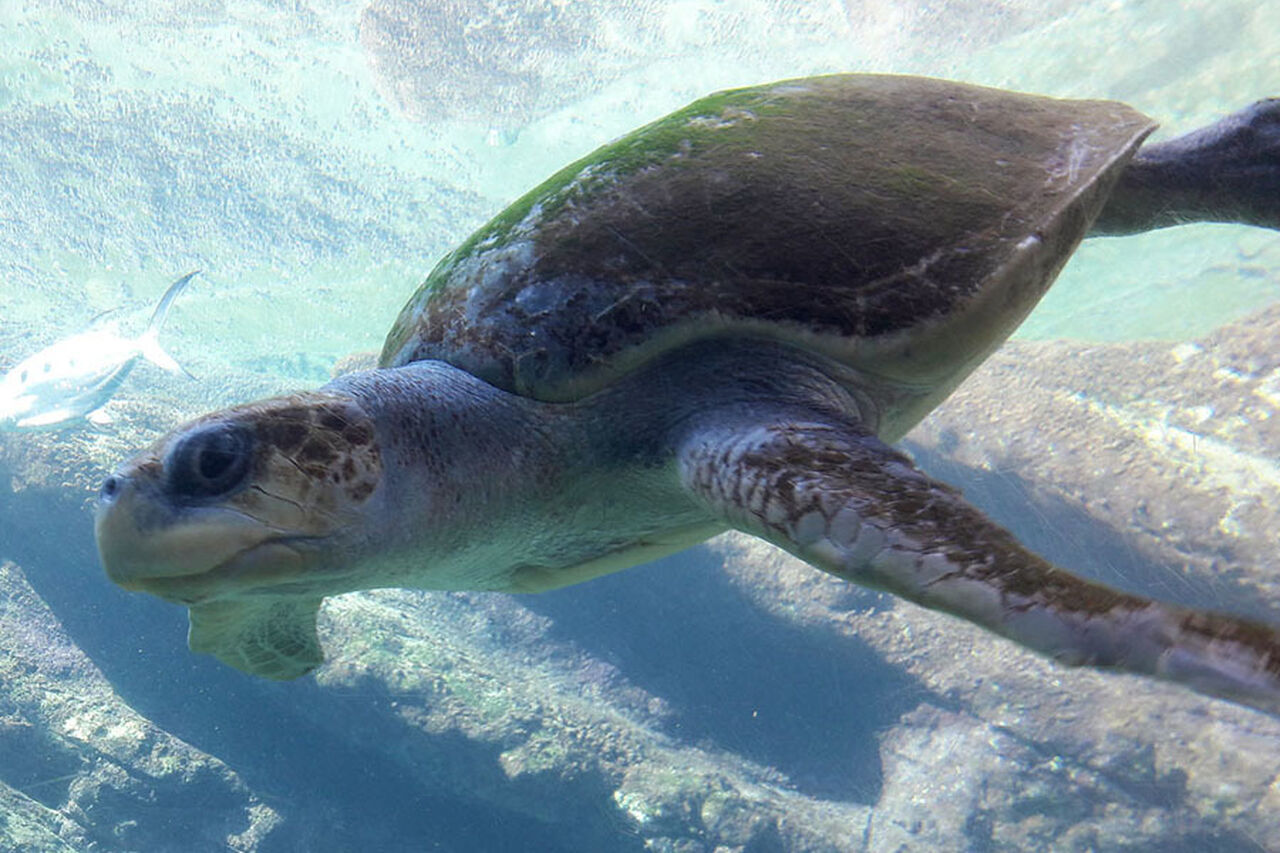
Pemba was released off Mabibi in Kwa-Zulu Natal, after a fantastic collaborative rehabilitation effort by both the Two Oceans Aquarium and uShaka Seaworld in Durban. She is a smart-swimmer and made great use of the currents. Pemba at some point made us think that she was heading towards Brazil, but she eventually veered back up the west coast of Africa and her last transmission was offshore, about 1 400 km south of Liberia. This position was 2 062km west of Luanda and 3 214 east of Brazil.
Straight line distance from the Two Oceans Aquarium is 3 821km. What an amazing international traveller – from the warm Indian ocean to the much cooler Atlantic ocean. The average temperature recorded throughout her journey was 20.22°C. She started off in March 2018 with a nice average of 24.7°C, and hit the cold Atlantic in May 2018 with an average temperature of 15.27°C for the month, and a minimum temperature recorded of 13.4°C – just shows you how tough these turtles are. Only once summer hit in the southern hemisphere did Pemba find warmer water again – and since January 2019 she was in a lovely 24 to 26°C water.
"I feel very fortunate that we managed to see Pemba thrive back in the ocean after a very long and tough rehabilitation period." - Two Oceans Aquarium Curator Maryke Musson
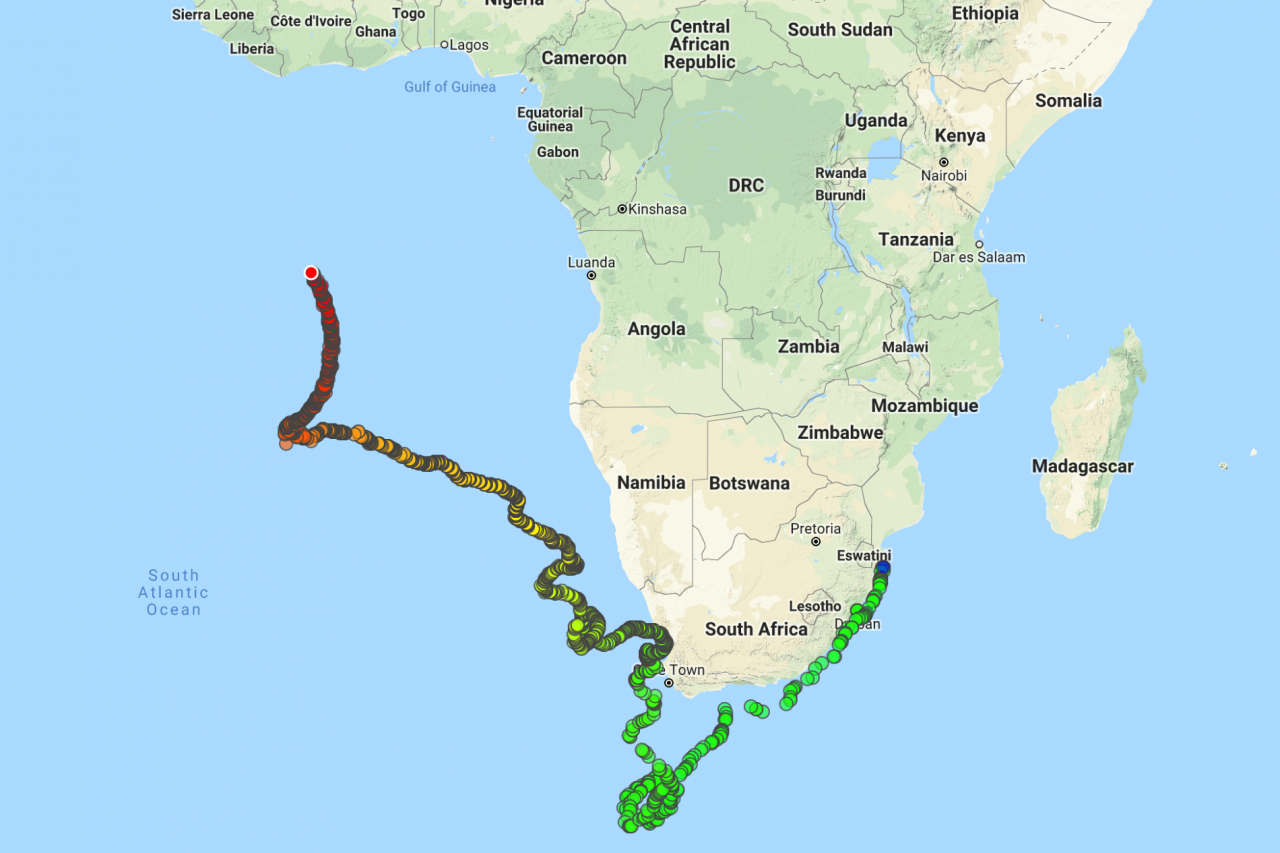
Sandy has, at long last, decided to leave her favourite surf spots, Elandsbay and Lambertsbay, and she is heading further up the West Coast, currently about 14km west of Doringbaai. This feisty green turtle, who survived a terrible boat strike injury near Witsand in the Western Cape, arrived in the Elandsbay area on 1 January 2019. This, of course, had us rather concerned as the water temperature there was on average between 10 to 13°C – not the ideal range for a sea turtle. However, Sandy managed quite well and raked up a very impressive 1 925km since release.
She is swimming against a strong NW wind at the moment, but with a bit of south-west swell behind her, and the temperature has risen to a still chilly 14°C. We are so proud of Sandy for persevering and also very thankful to the NSRI Lambertsbay and Fisheries Inspectors in Elandsbay who have been on standby just in case she decided to come to shore.
We are very excited to see where she will be going over the next few months. She has an enormous ocean to explore and much warmer water to be found. Her satellite tag has transmitted 9 547 messages from 1089 satellite passes, and hopefully many more messages to come.
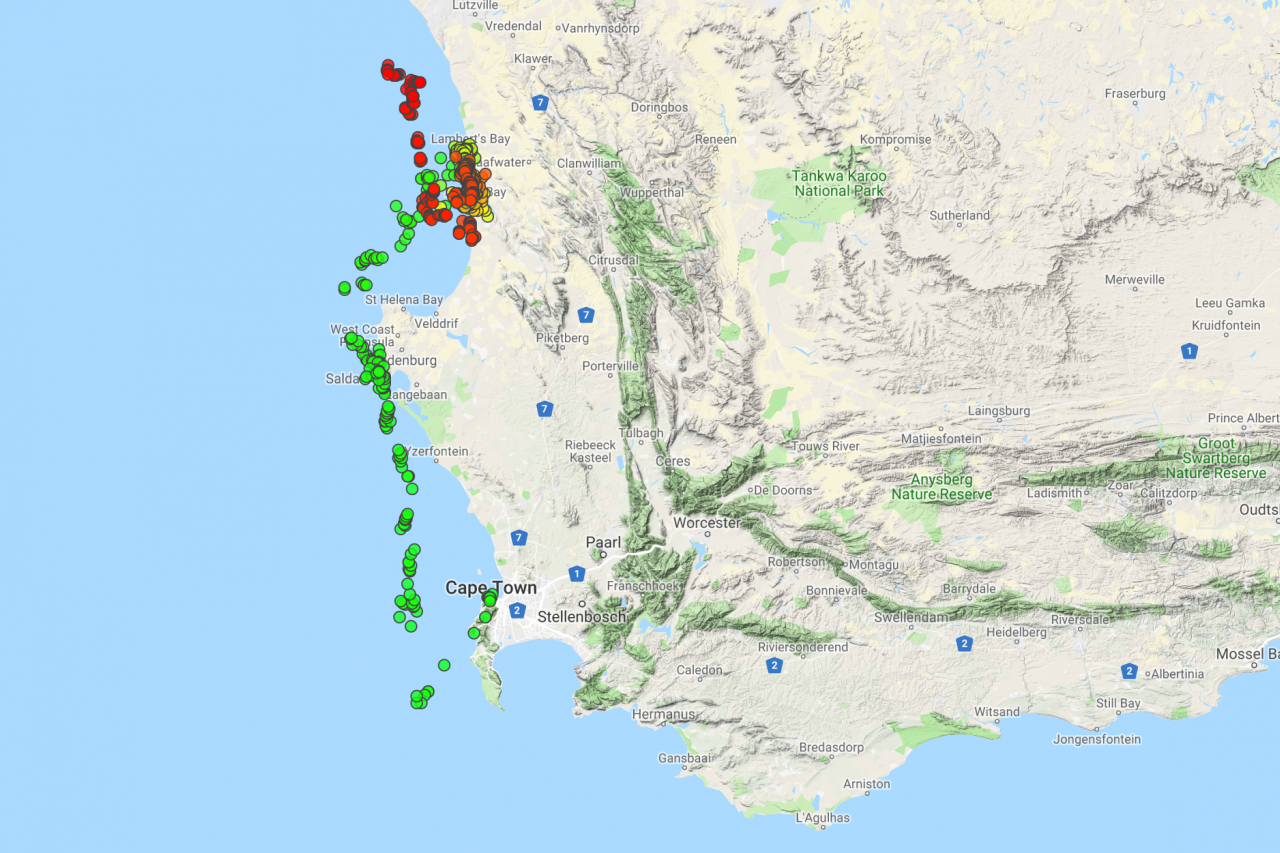
Yoshi has maintained her "just over a marathon per day" pace with an impressive 44km per day. She is clearly loving the Southwest Indian Ridge which has many feeding hotspots. She has just passed the Gazelle Fracture Zone. Fracture zones are common features in oceanic geology and consequences of plate tectonics. The Gazelle Fracture Zone was only discovered in 1995. She is heading straight towards the Atlantis II Fracture Zone, which was discovered in 1976 by the US research vessel Atlantic II.
She remains in a nice comfortable 20°C with a very slight north current. Yoshi is currently 1 415km south of Reunion and 2 018km north of Port aux Francaise, also called Desolation Island – which is mostly submerged by the southern Indian Ocean and one of the most isolated places on earth. She is still within the worldwide range of loggerhead sea turtles though, with 5 454km to go to get to Australia.
Yoshi’s tag is serving us very well and we have received 15 274 messages from 3 310 satellite passes.
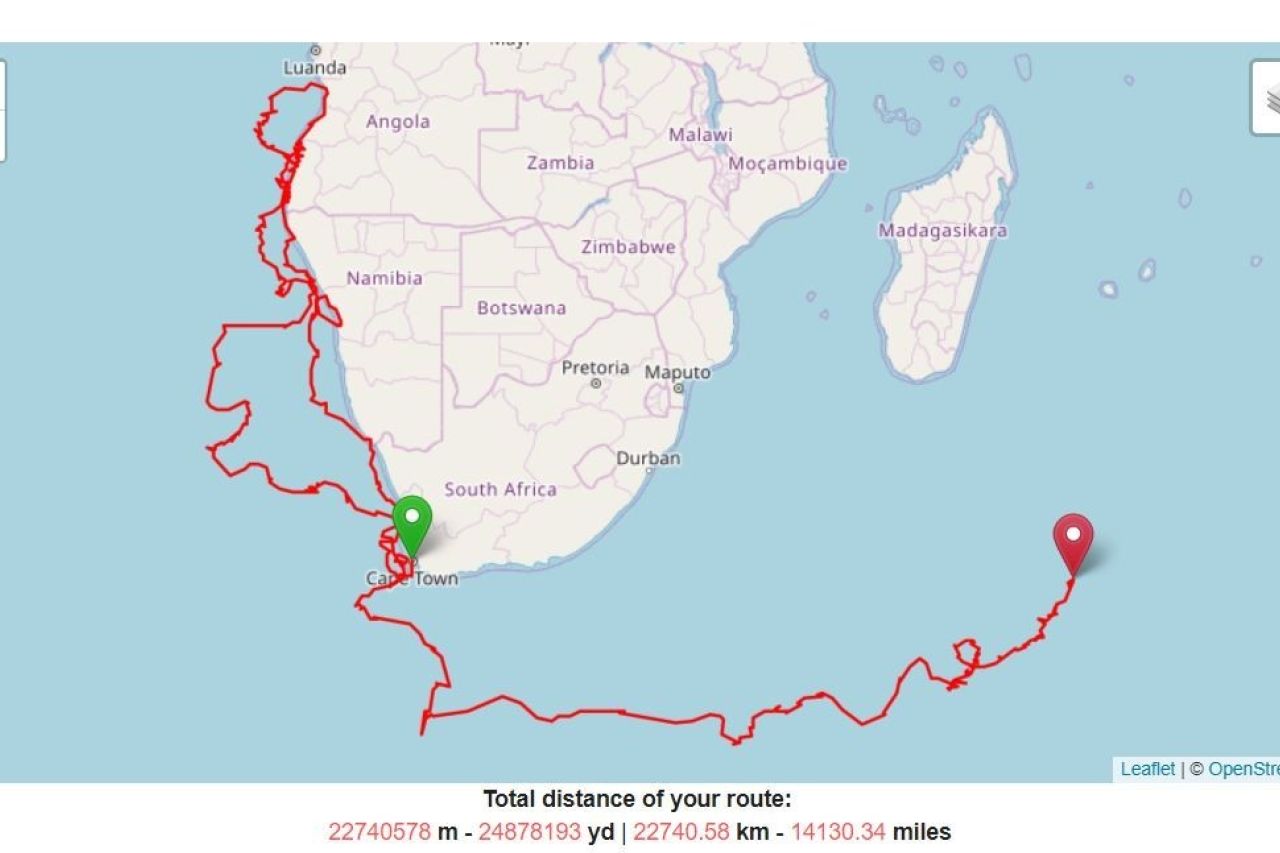
Noci is the champion with regards to average distance travelled per day. This loggerhead male has been back in the ocean for 150 days and is covering about 54.37km per day! How impressive is that!? He has travelled 8 156km since release – and has made some interesting turns along the coastline as well as deep offshore. His path has crossed that of Pemba and Yoshi. We have received 14 519 messages from 2 101 satellite passes. This is quite a lot, so we hope the battery on his satellite tracker will last longer than Pemba's.
Noci has spent most of his time in a very acceptable 19.45°C and is currently about 300km west of the Salt River estuary – an area that the turtles seem to really like; he was also seen hanging out in this area in December. He is now 452km NNW, straight line distance, from the Aquarium.
Noci’s tag has a very special depth gauge and it has been fascinating to see how deep he dives. His deepest dive thus far was 130 metres. The average depth of his dives since his release is 47.2 metres, however, he spends most of his time at about 2.5 metres below the surface.
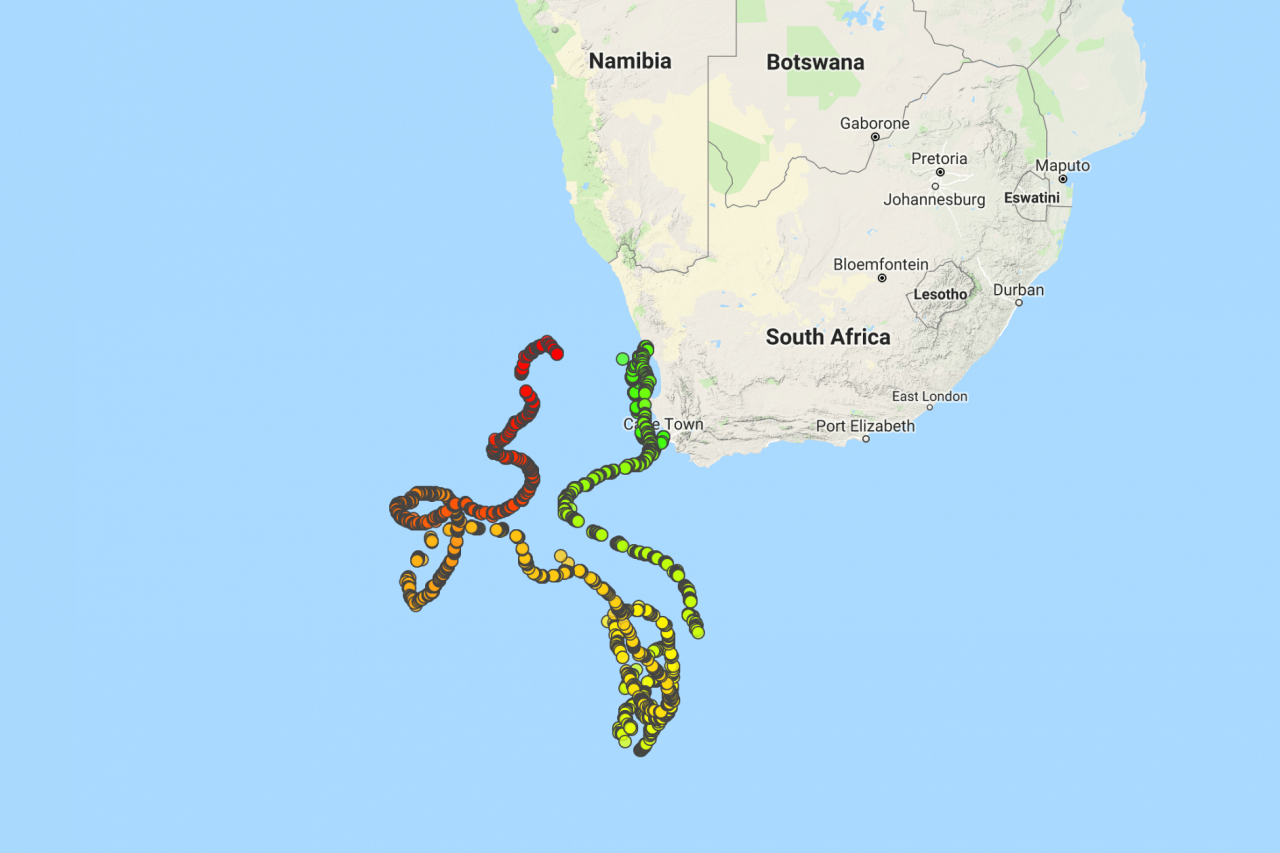
15 April 2019
Yoshi has now covered 21 156 km over the last 484 days, that is 44 km per day! Imagine running just over a marathon every day for 16 months! Her speed averages 1.8 km/h which is fast and we're convinced all that training, good meals, love and attention prepared her very well for life back in the ocean.
It now appears that she is well on her way towards Australia. She is about 1 300 km south of Madagascar and swimming along the Southwest Indian Ridge which bisects the ocean between Africa and Antarctic. This area is most certainly a good feeding ground as well. She is in a very mild 19°C water temperature in a north current with a northerly wind pushing quite strongly along the surface too.
Yoshi’s tag is serving us very well and has sent through 13 889 messages with 3 004 satellite passes. Her tag is set at 30-second intervals, which is preserving some battery power. The tag can only transmit when she surfaces and is in range of a passing satellite.
The nearest loggerhead turtle nesting sites are still those along our northern Natal coastline and Mozambique, but Australia and Oman both see many Loggerhead females nesting along their beaches every year. At this stage, Yoshi remains an ocean explorer, and only time will tell whether she will head to her original home beach while still being tracked (which of course will be incredible).
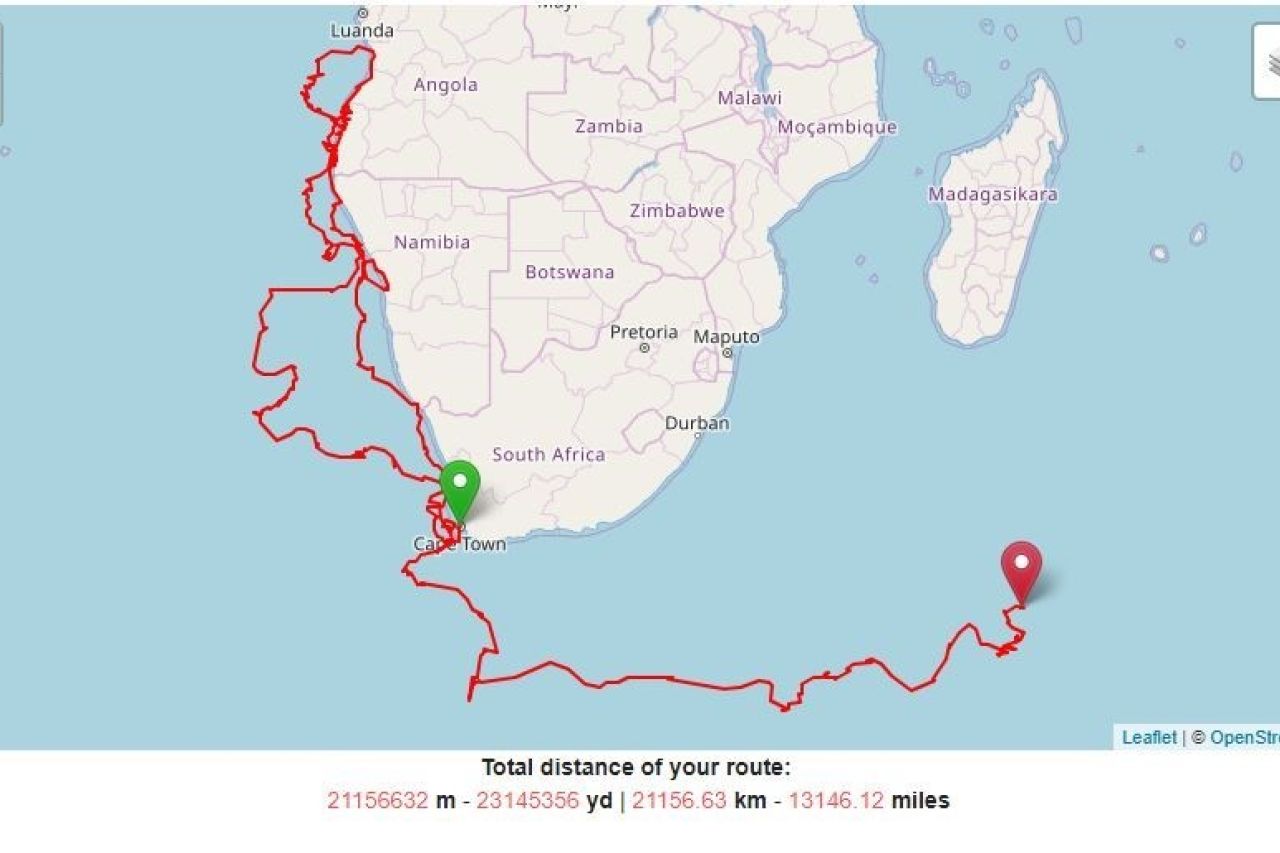
Pemba, the rehabilitated olive ridley turtle, is continuing her explorations in the Atlantic Ocean. Olive ridley sea turtles are smaller than loggerhead and green turtles and are found in the tropical and warm waters of the Pacific and Indian Oceans. They are not as common in the Atlantic Ocean, however, there are nesting sites along Angola, Congo and Gabon. Pemba was released off Mabibi in KwaZulu-Natal 402 days ago and has since travelled 15 839 km. That is an impressive 39 km/day – almost as fast as Yoshi!
We initially thought Pemba was heading towards Brazil, but over the last month she has spent quite a bit of time near St. Helena and seems to be heading for Angola now. Currently, she is 392 km north of St. Helena and about 1 916 km west of Angola with 3 400 km between her and Brazil.
She is swimming around some well-known table-mounts, also known as guyots. These are isolated volcanic sea mounts at least 900 meters tall. The South Atlantic has 43 such guyots. Again – these areas are rich fishing grounds and there should be plenty of food for her. Olive ridleys are mostly carnivorous, living on jellyfish, crustaceans, tunicates with the occasional bit of algae.
It will be quite incredible if Pemba heads for the nesting sites along the west coast of Africa. Olive ridley females have an average clutch size of about 116 eggs and incubation lasts 45 to 51 days, but can take up to 70 days in poor weather conditions. At the moment Pemba is in a lovely warm 28°C with a very gentle east current but a rather strong south-east surface wind.
Pemba’s satellite tag has passed 2034 satellites and has sent through 20 962 messages. This tag was set to send a message every 15 seconds and that is why we have received more data on Pemba than Yoshi.
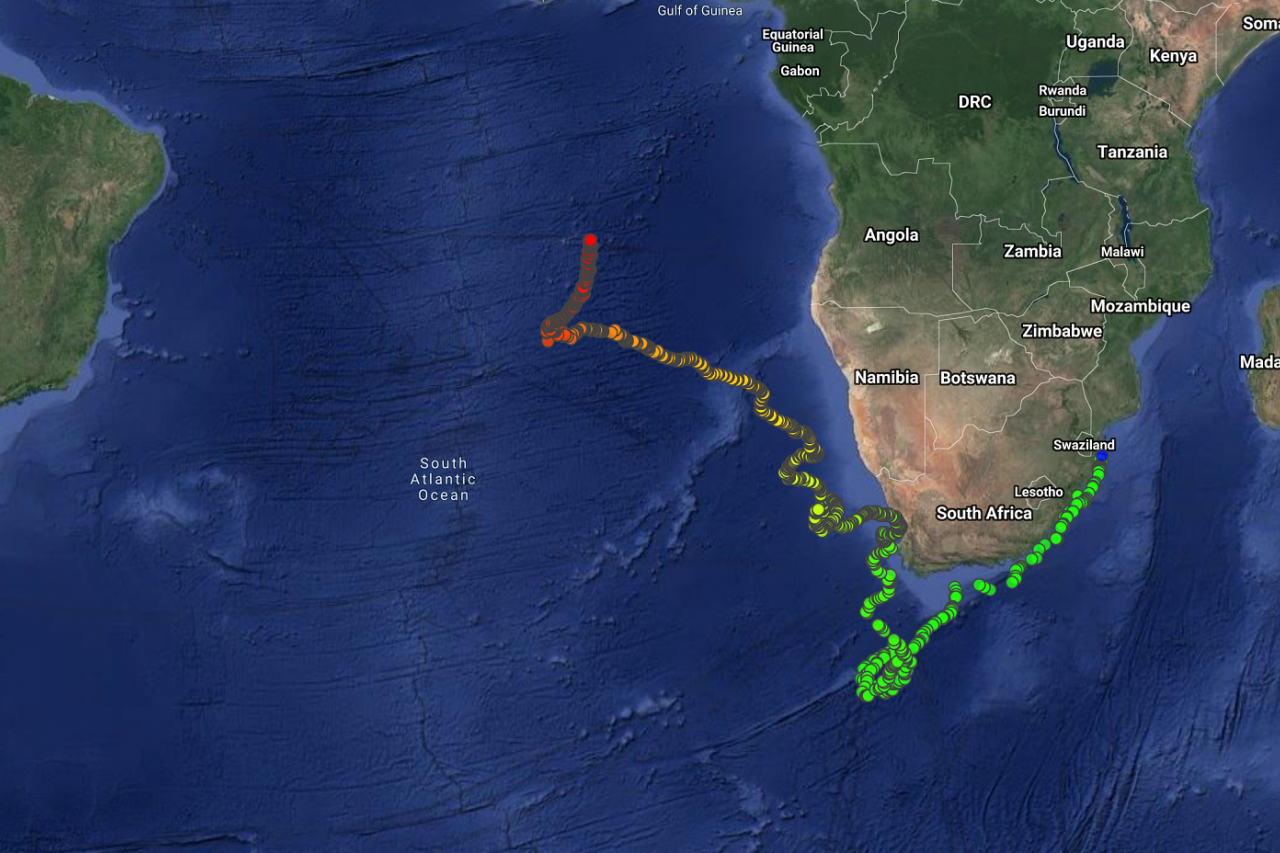
Noci, the beautiful and wild-looking loggerhead turtle, and only male sea turtle we have tagged to date, has been back in the ocean for 115 days. He did not have a long stay at our rehabilitation facility and it was a pleasure to release him back into the ocean in December 2018. Noci has travelled 6 600 km since his release – that is a very impressive 57 km per day! Imagine if he keeps this up!
He has impressed us with his travels, exploring close in-shore on the West Coast before heading back down into the south Atlantic and having a good look at various seamounts. Noci is certainly going with the flow and making good use of the currents. He has followed some of Pemba’s tracks and has crossed paths with Yoshi too.
He is currently about 870 km southwest of Cape Town near the Cape Basin seamount. He is in a very nice and mild 20°C water temperature in a circular current with a very strong southeasterly wind.
We have seen 1628 satellite passes from Noci and we have received 11 309 messages from his tracking device. Noci’s tag also registered depths of 130m – which is a very impressive diving depth. Noci is an incredible turtle all round and we are so happy he is doing so well back in the big blue ocean.
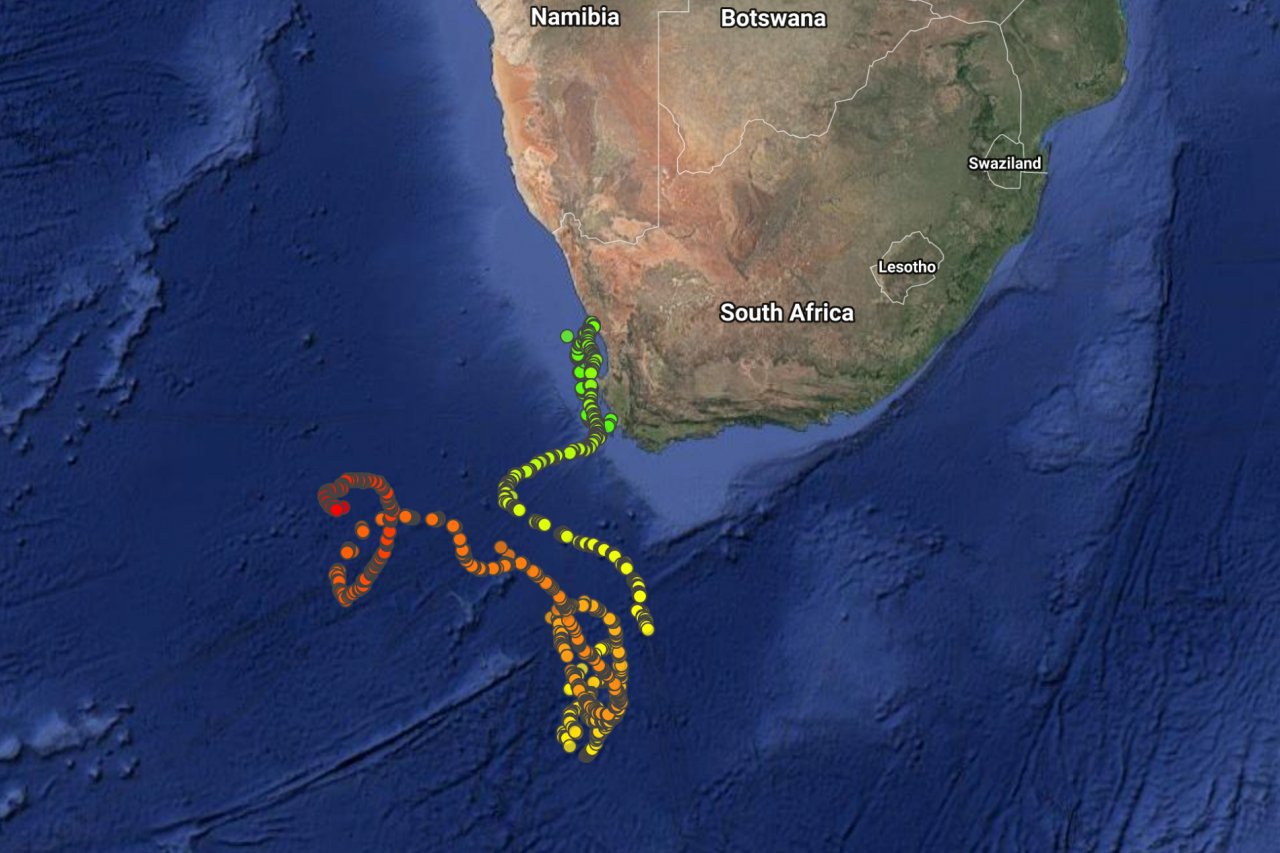
Last, but certainly not least is our West Coast girl, Sandy the green turtle, who has been spending most of her time between Elands Bay and Lambert's Bay. After a very long recovery at the Aquarium due to a serious boat strike injury, she is yet to decide where to head off to – which we are hoping will be sooner than later as green turtles do prefer warmer water.
Sandy has travelled 1 506 km since her release 115 days ago – which is a lot of swimming between her two favourite West Coast towns (also definite favourite spots for many surfers). She is in a bit of an on-shore wind at the moment and a very gentle north current and the water is a chilly 14°C. Sea turtles can cope well in cold water and just slow everything down a bit – but most certainly prefer more temperate and warmer water.
We have seen 766 satellite passes with 6 247 messages received – so she is certainly staying active!
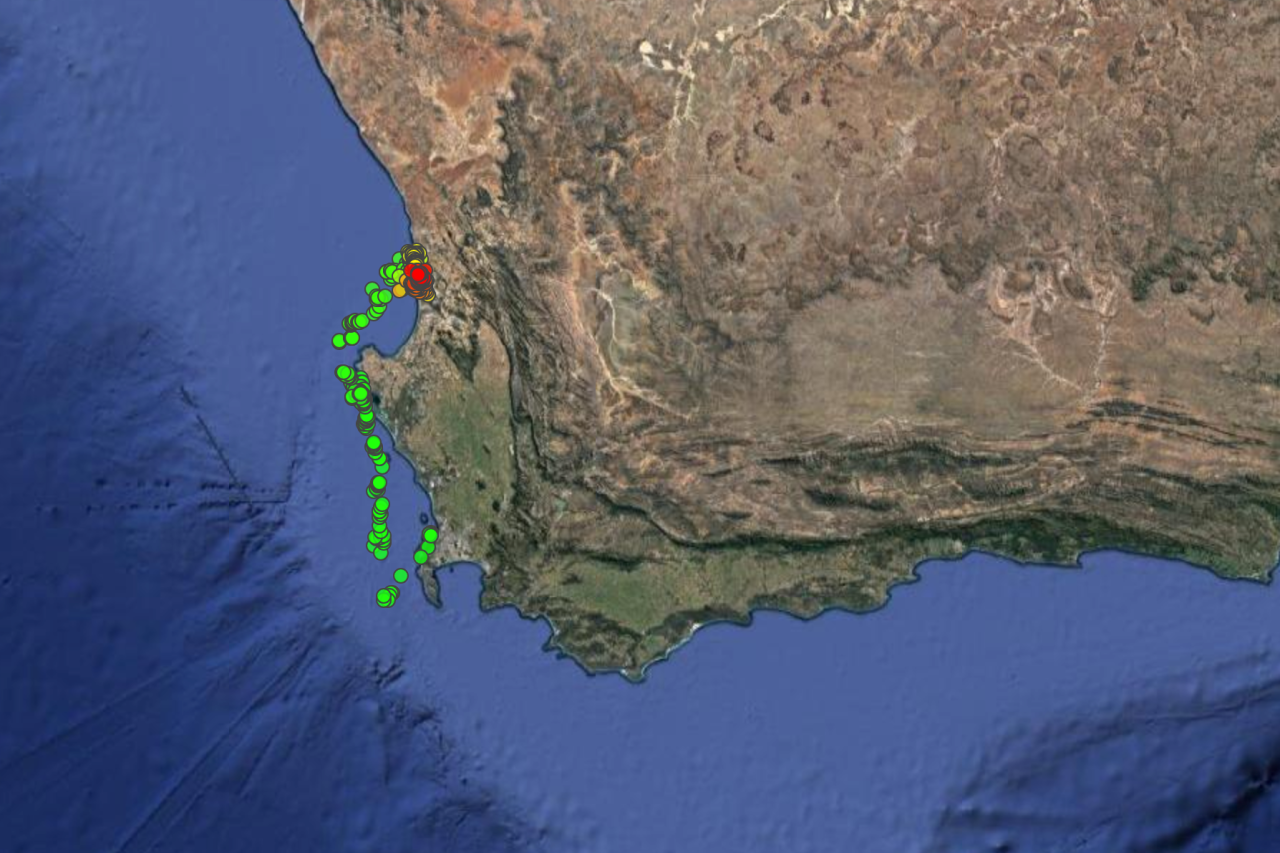
8 March 2019
Pemba: This olive ridley has been travelling the oceans for 365 days! This true seafarer was released on 8 March 2018 and has had quite a remarkable journey. Since January 2019, she has been exploring what seems to be the middle of the ocean, and we believe she is enjoying spending time in areas offering good food supply. She is currently 1 917km west of Africa and about 251km south of St Helena Island. Just another 3 500km to go and she will be off the coast of Brazil, where many olive ridley turtles breed. She is in a very gentle north-easterly current at the moment and in warm sea temperatures of about 25°C.
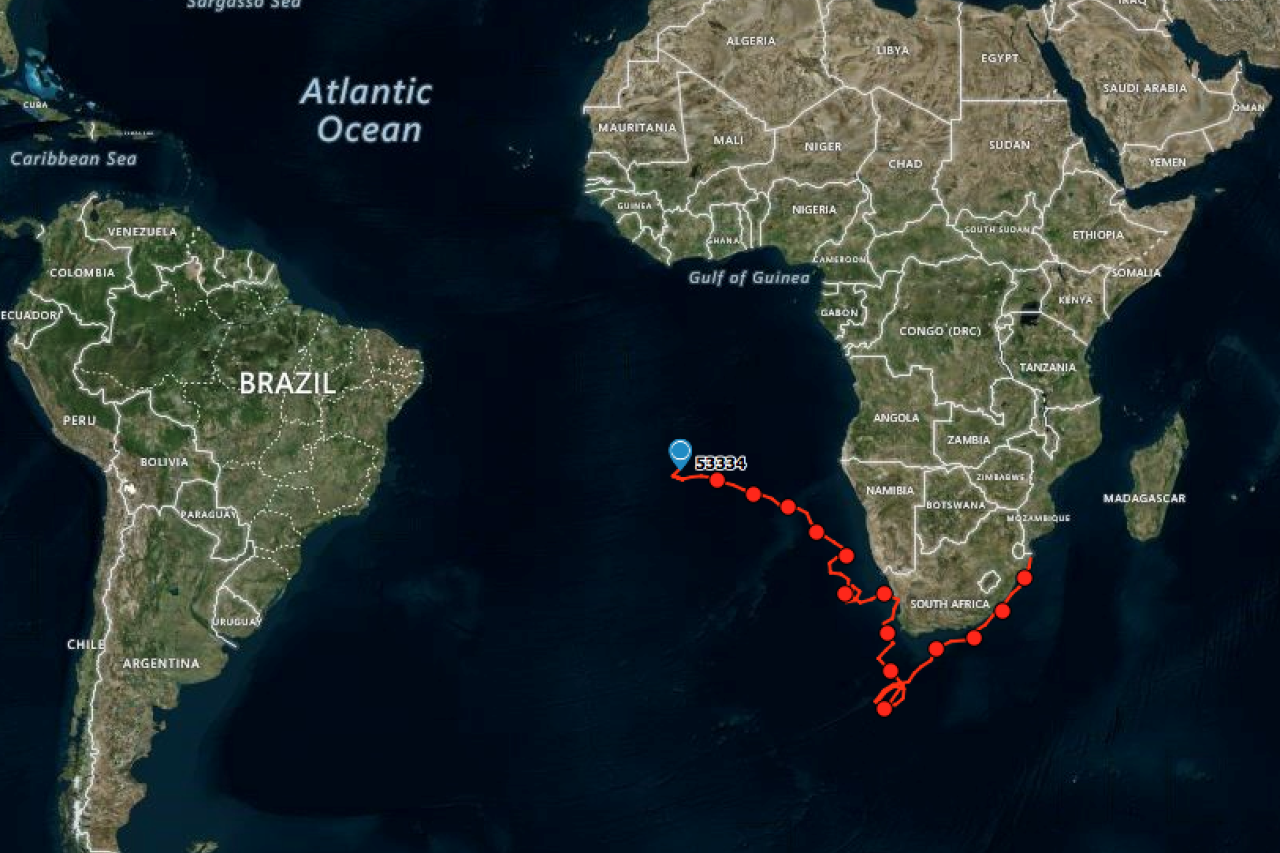
Over the last year, Pemba has travelled an impressive 14 381km! That is averaging 39.4km per day. Her fastest month was the month of release when she was cruising down the Agulhas Current at a very fast pace of 145 km per day. September 2018 was a rather slow holiday month, where she moved about 25.5km per day – exploring and feeding along the Walvis Ridge. She picked up the pace again in February 2019 – moving around and about south of St Helena – at an average speed of 66km/day.
What a fantastic achievement for a rescued turtle who for a very long time could not even dive under the surface of her rehabilitation tank. Thanks to the incredible care and dedication of the animal health and veterinary teams at uShaka Seaworld and Two Oceans Aquarium, Pemba continues to enjoy the open ocean and inspire us all with her determination.
Yoshi: 447 days back in the ocean and more than 18 500km covered. Yoshi has averaged 39.4km/day since her release and has crossed various borders, swam in various directions, still continues to swim against the currents, still visiting areas offering a lot of food and even visited the new Marine Protected Area around the Protea Seamounts. What a journey.
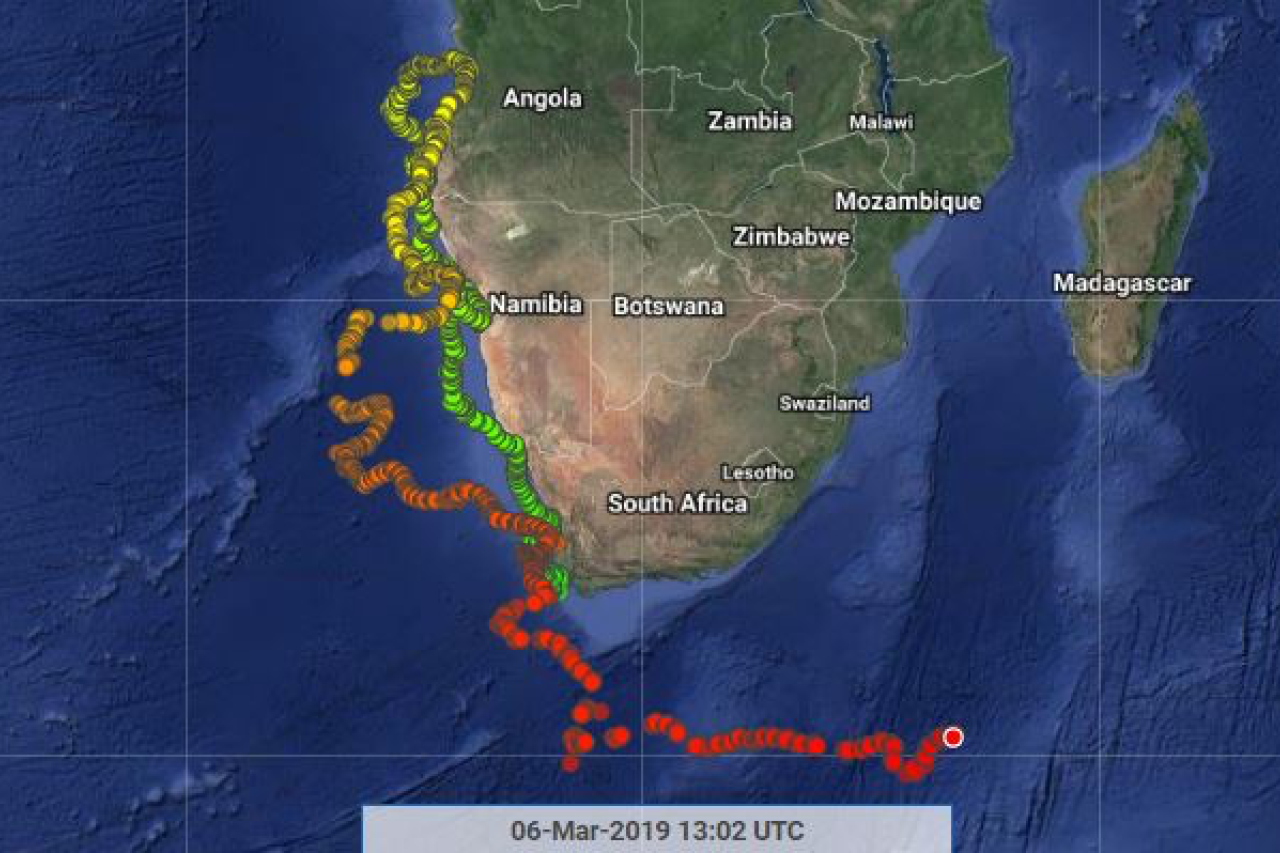
Right now it appears as if Yoshi is swimming towards Australia – where Loggerhead turtles do nest. She may also choose to head north to Madagascar or Mozambique - we're as excited as you are to find out!
She is about 1 700km south of Madagascar and 1 850km east of Cape Town. Only 6 700km to go to get to Australia! We fondly think back of all the swimming training we did with Yoshi – and it is obviously paying off.
Noci: Noci and Sandy have both been back in the ocean for 78 days, and Noci, the male loggerhead, has racked up the fastest average speed of all our tagged turtles. He has covered a very impressive 4 122km since release in December, with an average pace of 53km/day. Noci headed up the West Coast straight after release and went to go and check out the mineral-rich areas off the Salt River estuary before turning around and heading back south. He then crossed paths with Yoshi around the Protea and Simpson Seamounts before heading into the south Atlantic currents and eddies, pretty much where Pemba did her roundabouts. Noci is being pushed by a rather strong southerly wind at the moment and is in a very acceptable temperate 20°C. This wild one is doing so well and it is really exciting having the opportunity of following a male loggerhead turtle.
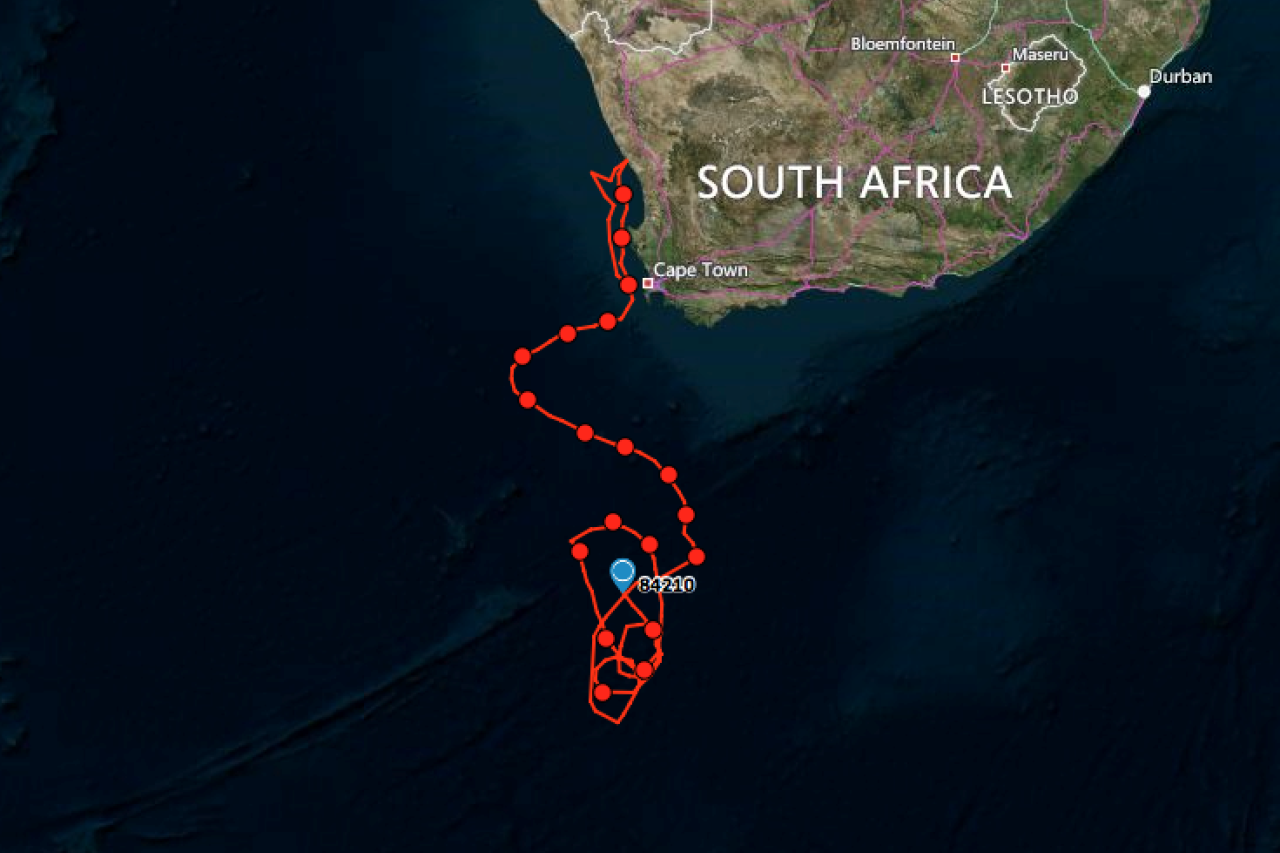
Sandy: Since her release, Sandy has spent most of her time moving between Elands Bay and Lambert’s bay. We can’t help thinking that the presence of our two surfer dudes, Deen and Kevin, on release day somehow contributed to her choosing to go hang out in Elands Bay.
She has now covered 1 223km, at an average pace of about 16km/day. Bearing in mind that the water temperature has ranged between a chilly 9°C and 18°C, it is rather impressive that she has kept such a good swimming speed.
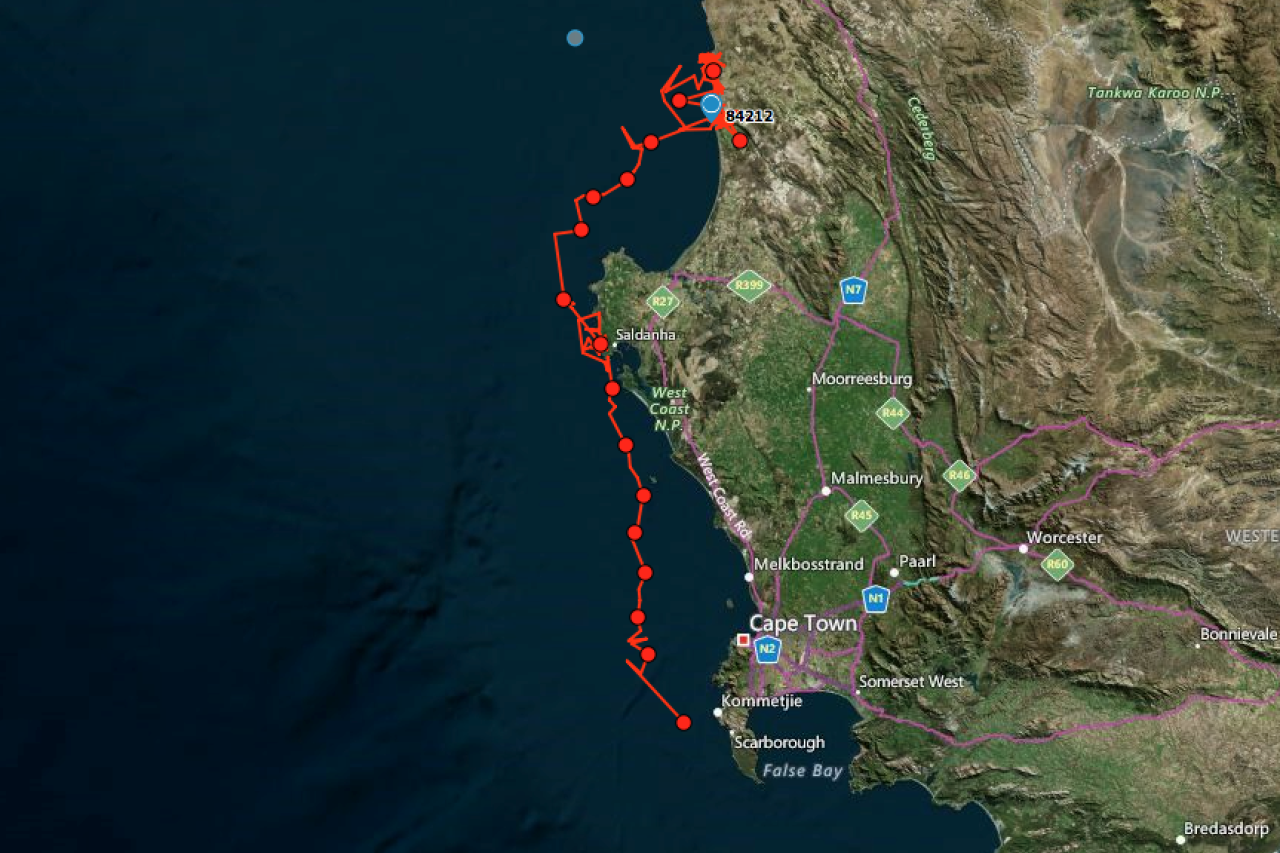
Pemba has since crossed the Walvis Ridge and is currently 1 906 kilometres west of the Namibian/Angolan border and 3 515 kilometres east of Brazil. She has travelled more than 12 700 kilometres! She has been back in the ocean for 333 days already and it looks like she is heading towards Brazil, where there are quite a few olive ridley turtle nesting sites (although it is still too early to be certain). She has a nice strong easterly wind behind her at the moment and is likely loving the 25°C water she finds herself in. Pemba was a challenging medical case – and it is lovely to see her crossing oceans!
4 January 2019
Noci: Noci, the large male loggerhead, headed straight up the West Coast after release off Cape Point and passed Saldanha bay by the 22 December 2018. He then continued up the West Coast, close to shore just past the Soutriver Estuary near Malkopbaai on the 27 December. This is exactly the area where Pemba, the olive ridley turtle released off the KwaZulu-Natal coast in March 2018, went very close to shore 3 months after her release, and about 30 kilometres north of where Yoshi, the loggerhead female, spent a few days very close to shore early January 2018. We are very keen to find out what attracts the turtles to that spot.
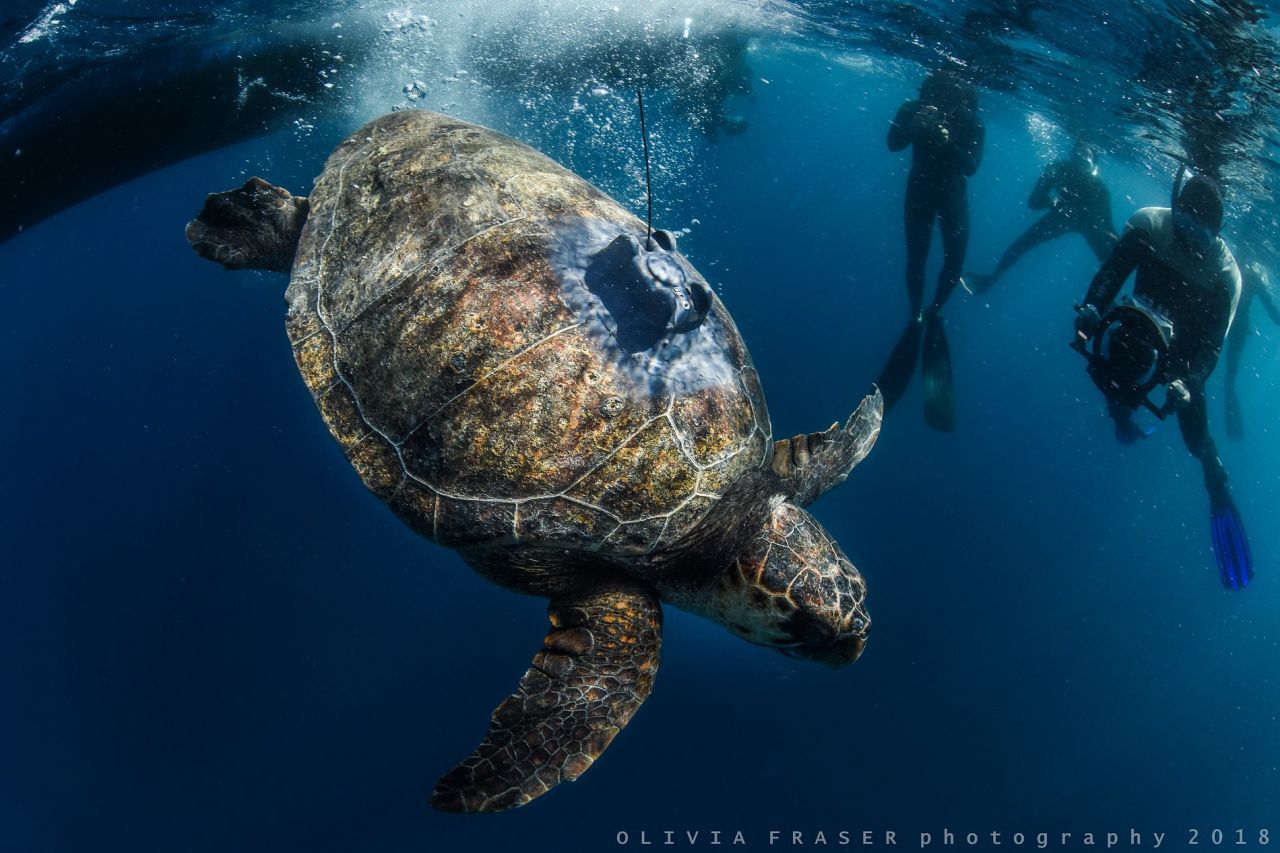
By 29 December she started moving north again (much to our relief ) and passed St Helena Bay on New Years Day. She literally came within 10 kilometres of Noci who was heading back down the coast at the time. She is currently about 22km southwest of Lamberts Bay – swinging past the great NSRI crew and about 29km northeast of Noci. The water temperature is about 17°C – still nice and warm for the West Coast, but at the lower end of her preferred range, and she is swimming with a slight current from the south.
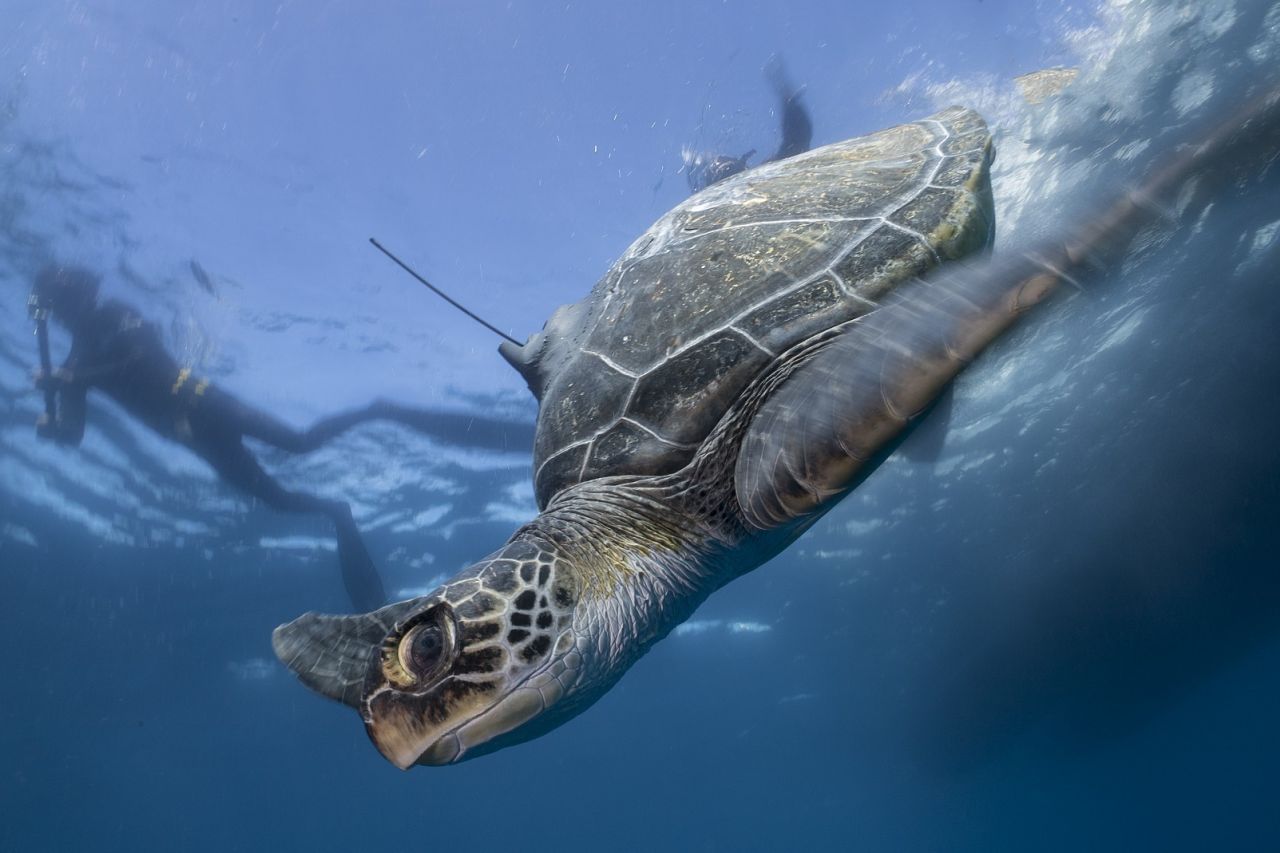
We have learned from Yoshi that turtles can adapt back into the ocean very well after extended time periods in captivity and that they are true oceanic travellers – she might very well swim around the ocean for another few years before nesting, and to date, we still have no idea where she is originally from. Our best guess at the moment is most likely from one of the Indian Ocean loggerhead populations.
Pemba: Pemba has been back in the ocean for 301 days and is currently about 380km northwest of the island of Saint Helena in the Atlantic Ocean – 1650km west of Oranjemund. Pemba has now travelled more than 11 900km - an impressive 39.5km per day. She has slowed down over the last few weeks but is still using the currents to her advantage and she finds herself in 24.5°C water at the moment. She is a third of the way across the Atlantic Ocean towards Brazil. What an impressive journey!
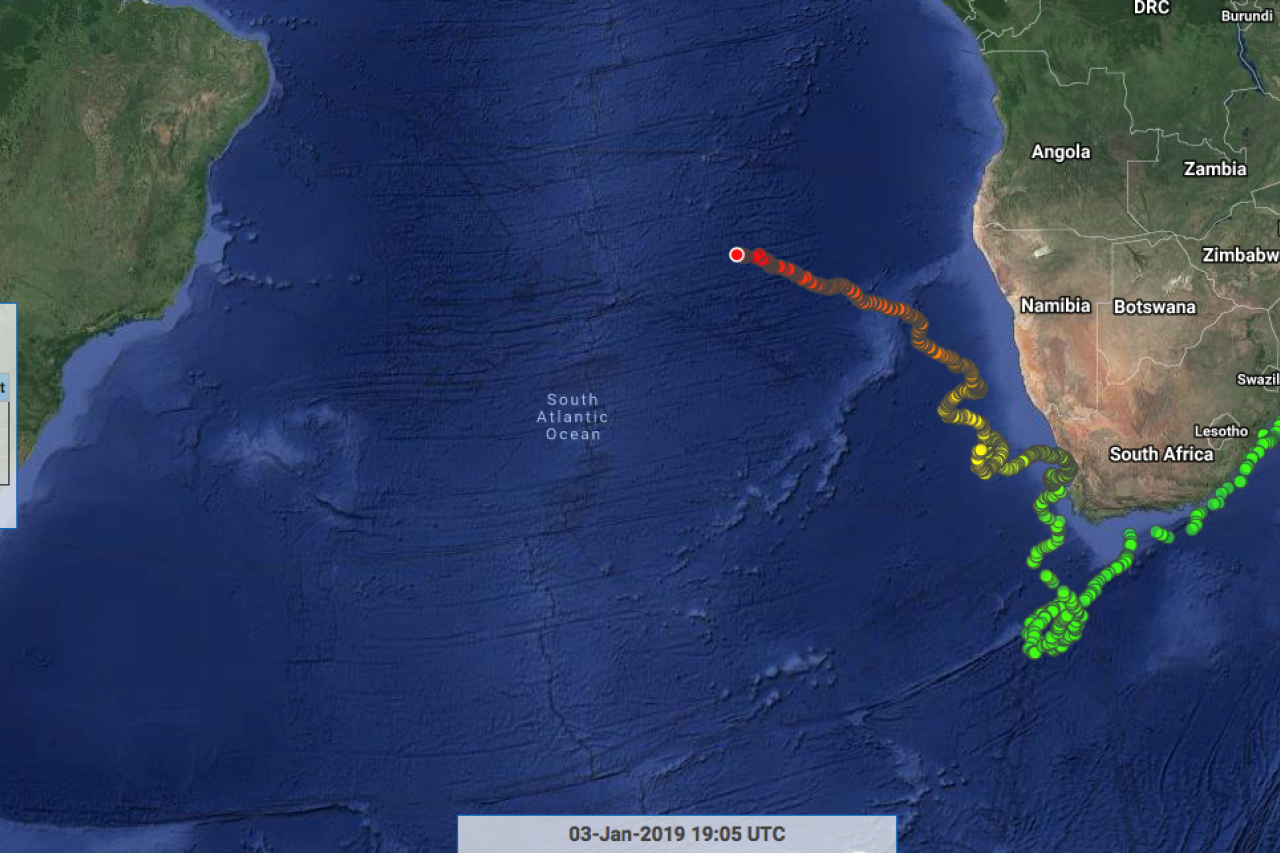
We are very fortunate to be able to work with the Department of Environmental Affairs to track the movements of these turtles and, thanks to generous donations by some of our funders, we were able to tag both Sandy and Noci recently and follow their journeys since their release on 20 December 2018.
Sandy is a female green turtle that was rescued by the Lower Breede River Conservancy Trust in September 2016 after having her carapace badly damaged by an apparent boat propeller strike. We didn't think Sandy would make it - but this resilient turtle has turned out to be the ultimate survivor. Noci was also rescued near Witsand, on 29 April 2018, and through the combined efforts of the family who foun
